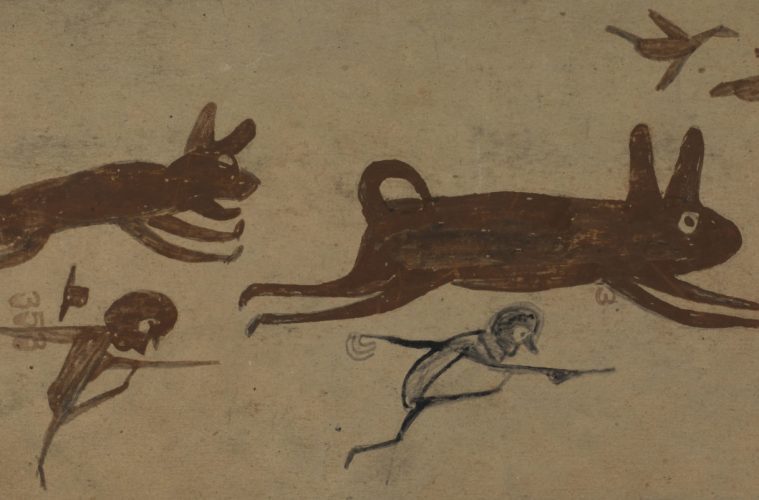Sometimes the circumstances of an artist’s life are as inseparable from their vision as the dancer from the dance. So it is with the remarkable story told in the new film Bill Traylor: Chasing Ghosts. An absolutely unique figure in American art, Traylor’s work is defined by a folkloric style, a confident hand with a gift for almost petroglyphic clarity, narrating a character-driven universe of observation, rural mysticism, biography, memory and vernacular history. His life story is equally fascinating.
Traylor was born into slavery in 1853 in Alabama and, with a special talent for farming the land, after the Civil War continued to live and work there until 1920; living through Reconstruction and Jim Crow; eventually settling in Montgomery where he died in 1949 – decades before his first real art shows would even happen, much less the acclaim, demand, and scholarship that surrounds his oeuvre now. The new documentary Bill Traylor: Chasing Ghosts weaves all these stories into one remarkable biography with a seismic impact on art history.

Bill Traylor in Montgomery, AL
Traylor started to draw and paint to greater public attention when he was already in his 80s, literally on the bustling Montgomery sidewalk, where he was something of a neighborhood celebrity. He sold some work in his lifetime for small sums, and found some local champions even as he continued to work prolifically, developing and strengthening his signature style. Partly because of how he favored ephemeral materials like paper and cardboard, and partly because of some cruel twists of fate, troves of his work have been lost to time – scattered among untraceable buyers, painstakingly located among his extended family of descendants, and at times outright, unknowingly thrown away.

Bill Traylor
But enough of the 1,000 or so works he made between 1939-42 survived to mount the exceptional Between Worlds: The Art of Bill Traylor, an exhaustive 2018 retrospective at the Smithsonian American Art Museum. And it is this paradigm-shifting show which forms much of the basis for the new film. By placing Traylor’s arresting work within both the broader historical and more intimate family contexts, the film begins to decode his exquisite narrative language, identifying characters and specific events to profoundly illuminate the work’s many links between complex personal memories and the symbolism of trauma and empire.
At the same time, the film – especially its many interviews with scholars, critics, and with artists who have been influenced by Traylor’s legacy – shows how Traylor’s vision not only encapsulated but also transcended the circumstances of his lifetime in America. Traylor’s special gift was for reaching back through Black America’s rich oral and mystical traditions, music and folklore all the way to the African roots of storytelling and conjuration, and across to the formulation of new Southern-seeded, increasingly urban cultures in dance, in literature, and most especially, the Blues.

Bill Traylor
With recurring motifs like the old farmhouse, animals like snakes, cats, birds, dogs, and wolves, tools, drinks, and a lot of dancing, Traylor arranged sketches but also staged complex scenes, with intuitively understood narratives, a dramatic sense of movement, increasing confidence and mystical, spellcasting reimaginings of monuments to white supremacy and other power structures.

Bill Traylor
Traylor’s work is described in the film as “apparitional” and “mysterious” but never as “outsider” because in a very real sense, Traylor had the ultimate insider view of the real America. This is brought home not only by the experts’ commentary, but by extensive juxtapositions with family members recounting the tales of Traylor that circulated among many cousins, grandchildren, and great-grandchildren. The film has actors reading from contemporaneous accounts and records, as well as salient works by Zora Neal Hurston and Langston Hughes – all of which contributes to getting as much of a sense of the whole person as possible, beyond gaining an essential understanding of the transformative work itself.
On demand through local theatrical streaming platforms here: kinomarquee.com.

Advertising disclosure: We may receive compensation for some of the links in our stories. Thank you for supporting Irvine Weekly and our advertisers.

